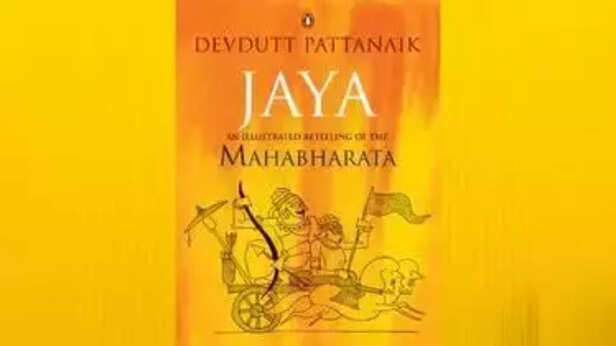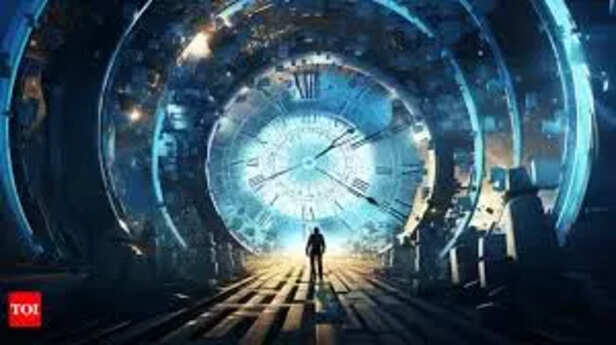Is Time Travel Hidden in Hindu Scriptures?
Riya Kumari | Jan 31, 2025, 23:59 IST
( Image credit : Times Life Bureau )
The idea of time travel is one that captures the imagination. It's the kind of thing we expect to see in science fiction — in films, books, and the occasional daydream. But what if I told you that the concept of time travel, or at least a deeply sophisticated understanding of time, was present in ancient Hindu scriptures? What if these texts, filled with stories of gods, sages, and cosmic battles, held the keys to an understanding of time far beyond what we recognize today?
Time, as we understand it, is a river — a continuous flow from past to present to future. But what if that flow is not as straightforward as we think? What if time is more cyclical, malleable, and interconnected in ways we’ve only begun to scratch the surface of? Hindu scriptures, with their profound philosophical insights, seem to suggest that this is not merely a fanciful notion. In fact, they might have understood time not just as a measure of existence, but as something that bends, stretches, and folds within the very fabric of the cosmos.
The Vedas: Beyond the Linear Path of Time

At the heart of Hindu cosmology lies the concept of time as a grand, cyclical process. The Vedas, the oldest of Hindu scriptures, provide a picture of the universe that defies our conventional understanding of time. In the Vedas, time is not a straight line, but a cycle — one that repeats in a cosmic rhythm that’s beyond the grasp of ordinary human experience. This cyclical view of time is represented by the Yugas, or the ages of the world, which move from a golden age of truth (Satya Yuga) to a final age of degeneration (Kali Yuga). Each cycle spans millennia, but the key idea here is that time is never static. It moves, evolves, and returns, over and over again.
So, while we may be accustomed to thinking of time as something that moves forward in a predictable fashion, the Vedas remind us that time is fluid — it can loop, stretch, and overlap. In this sense, the Vedic understanding of time can be seen as an early glimpse into what we might now think of as time travel: not in the way we imagine hopping from one moment to another, but in the sense of time itself being a vast, dynamic, and interconnected reality.
The Upanishads: Time as a Mental Construct

The Upanishads take this even further, suggesting that time, as we perceive it, is not fixed but is deeply tied to consciousness. According to these ancient texts, the mind has the ability to transcend time altogether. In deep meditation, a yogi or sage can transcend the ordinary flow of time and experience past, present, and future as a unified whole. The Upanishads describe time as a mental construct — one that is relative to the observer.
Imagine this: when you are deeply absorbed in a moment — whether in a moment of joy or intense focus — time seems to stretch or compress. An hour might pass in what feels like a few minutes, or a few minutes might feel like an eternity. The Upanishads suggest that this is not just a psychological trick but a reflection of the deeper reality of time. In other words, our perception of time is limited, and true understanding can only be achieved by transcending those limits.
The Mahabharata: Divine Interventions in Time

The Mahabharata, one of the greatest epics of Hindu tradition, is more than just a tale of a family war. It contains stories that challenge our understanding of time itself. Take the character of Krishna, for example. He is not merely a divine being who intervenes in the affairs of humans. He is a being who moves effortlessly between the past, present, and future, reshaping events with his wisdom and guidance.
One of the more striking episodes that suggest a bending of time involves King Revati. Seeking wisdom and guidance, Revati follows a sage’s instructions to travel to the divine realm. When he returns, he finds that while only moments have passed for him, on Earth, centuries have gone by. This story isn’t just about a magical realm — it’s about the relationship between time and the soul, how time itself can be manipulated through divine intervention and spiritual awareness.
Krishna, in his ability to weave through the fabric of time, reflects the idea that time is not simply a linear progression but something that can be understood, influenced, and even transcended by those who possess the wisdom to see beyond its boundaries. This isn’t time travel in the sense of jumping from one moment to another, but it is the acknowledgment that time, as we understand it, is relative and influenced by higher forces.
The Secret of the Akashic Records

Hindu tradition also offers the concept of the Akashic Records, which are often described as the cosmic repository of all knowledge — everything that has ever happened and everything that will ever happen. The idea here is not simply that time is linear, but that every moment, every action, every thought, exists in an eternal record. This record is not static; it’s dynamic and accessible to those who can tap into it through meditation, spiritual practice, or divine insight.
The Akashic Records present a view of time as a vast web of interconnected moments, and those who can access this web can see the past, present, and future as one continuous whole. This knowledge isn’t simply about predicting the future; it’s about understanding the timeless nature of existence. The sages and rishis of ancient times, through their deep meditation and spiritual practice, were believed to have access to this cosmic archive — allowing them to see time as a fluid, ever-present phenomenon.
The Vedas: Beyond the Linear Path of Time

Vedas
( Image credit : Times Life Bureau )
At the heart of Hindu cosmology lies the concept of time as a grand, cyclical process. The Vedas, the oldest of Hindu scriptures, provide a picture of the universe that defies our conventional understanding of time. In the Vedas, time is not a straight line, but a cycle — one that repeats in a cosmic rhythm that’s beyond the grasp of ordinary human experience. This cyclical view of time is represented by the Yugas, or the ages of the world, which move from a golden age of truth (Satya Yuga) to a final age of degeneration (Kali Yuga). Each cycle spans millennia, but the key idea here is that time is never static. It moves, evolves, and returns, over and over again.
So, while we may be accustomed to thinking of time as something that moves forward in a predictable fashion, the Vedas remind us that time is fluid — it can loop, stretch, and overlap. In this sense, the Vedic understanding of time can be seen as an early glimpse into what we might now think of as time travel: not in the way we imagine hopping from one moment to another, but in the sense of time itself being a vast, dynamic, and interconnected reality.
The Upanishads: Time as a Mental Construct

Upanishad
( Image credit : Times Life Bureau )
The Upanishads take this even further, suggesting that time, as we perceive it, is not fixed but is deeply tied to consciousness. According to these ancient texts, the mind has the ability to transcend time altogether. In deep meditation, a yogi or sage can transcend the ordinary flow of time and experience past, present, and future as a unified whole. The Upanishads describe time as a mental construct — one that is relative to the observer.
Imagine this: when you are deeply absorbed in a moment — whether in a moment of joy or intense focus — time seems to stretch or compress. An hour might pass in what feels like a few minutes, or a few minutes might feel like an eternity. The Upanishads suggest that this is not just a psychological trick but a reflection of the deeper reality of time. In other words, our perception of time is limited, and true understanding can only be achieved by transcending those limits.
The Mahabharata: Divine Interventions in Time

Mahabharat book
( Image credit : Times Life Bureau )
The Mahabharata, one of the greatest epics of Hindu tradition, is more than just a tale of a family war. It contains stories that challenge our understanding of time itself. Take the character of Krishna, for example. He is not merely a divine being who intervenes in the affairs of humans. He is a being who moves effortlessly between the past, present, and future, reshaping events with his wisdom and guidance.
One of the more striking episodes that suggest a bending of time involves King Revati. Seeking wisdom and guidance, Revati follows a sage’s instructions to travel to the divine realm. When he returns, he finds that while only moments have passed for him, on Earth, centuries have gone by. This story isn’t just about a magical realm — it’s about the relationship between time and the soul, how time itself can be manipulated through divine intervention and spiritual awareness.
Krishna, in his ability to weave through the fabric of time, reflects the idea that time is not simply a linear progression but something that can be understood, influenced, and even transcended by those who possess the wisdom to see beyond its boundaries. This isn’t time travel in the sense of jumping from one moment to another, but it is the acknowledgment that time, as we understand it, is relative and influenced by higher forces.
The Secret of the Akashic Records

Time travel
( Image credit : Times Life Bureau )
Hindu tradition also offers the concept of the Akashic Records, which are often described as the cosmic repository of all knowledge — everything that has ever happened and everything that will ever happen. The idea here is not simply that time is linear, but that every moment, every action, every thought, exists in an eternal record. This record is not static; it’s dynamic and accessible to those who can tap into it through meditation, spiritual practice, or divine insight.
The Akashic Records present a view of time as a vast web of interconnected moments, and those who can access this web can see the past, present, and future as one continuous whole. This knowledge isn’t simply about predicting the future; it’s about understanding the timeless nature of existence. The sages and rishis of ancient times, through their deep meditation and spiritual practice, were believed to have access to this cosmic archive — allowing them to see time as a fluid, ever-present phenomenon.
